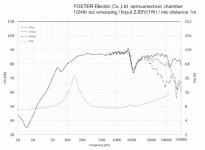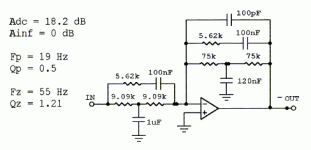Actually I want to have a two stage filter - first a notch filter, second a peak filter. But I want to have only one op-amp stage.
Maybe in a similar kind of the circuit under number 9) - go to
https://www.linkwitzlab.com/filters.htm
and
http://www.hornlautsprecher.de/download_dichtung.htm (page 203)
and the attached circuit.
Most important is a peak filter - some attenuation can be realized with help of parts for passive crossover networks.
If all full range drivers such perfect frequency response was had as to find under
https://sbacoustics.com/wp-content/uploads/2020/02/3in-SB10PGC21-4.pdf
not such stages was necessary - unfortunately there are not a big selection of such drivers.
Frequency responses from a lot of drivers looks like this examples from FOSTEX:
https://www.fostexinternational.com/docs/speaker_components/pdf/P800K-P1000K.pdf
https://www.fostexinternational.com/docs/speaker_components/pdf/P650K_OM_E_r2.pdf
https://www.fostexinternational.com/docs/speaker_components/pdf/P650K_OM_E_r2.pdf
https://www.fostexinternational.com/docs/speaker_components/pdf/FE83NV2.pdf
https://www.fostexinternational.com/docs/speaker_components/pdf/FE206NV2.pdf
https://www.fostexinternational.com/docs/speaker_components/pdf/FE103NV2.pdf
https://www.fostexinternational.com/docs/speaker_components/pdf/FE108NS.pdf
If one can see, narrow-band peak/dip is clearly recognizable and also to find at many others. Not making an equalizing does not have any major disadvantages - but nevertheless it is better to eliminate such anomaly in the frequency response - caused by the diaphragm and its suspension.
one example for a midrange
https://www.precision-devices.com/products/all-products/pd-615c002/
Thanks for an advice to associated URL's - I think, such equalizing stage must actually exist because this issue is relatively common.
Maybe in a similar kind of the circuit under number 9) - go to
https://www.linkwitzlab.com/filters.htm
and
http://www.hornlautsprecher.de/download_dichtung.htm (page 203)
and the attached circuit.
Most important is a peak filter - some attenuation can be realized with help of parts for passive crossover networks.
If all full range drivers such perfect frequency response was had as to find under
https://sbacoustics.com/wp-content/uploads/2020/02/3in-SB10PGC21-4.pdf
not such stages was necessary - unfortunately there are not a big selection of such drivers.
Frequency responses from a lot of drivers looks like this examples from FOSTEX:
https://www.fostexinternational.com/docs/speaker_components/pdf/P800K-P1000K.pdf
https://www.fostexinternational.com/docs/speaker_components/pdf/P650K_OM_E_r2.pdf
https://www.fostexinternational.com/docs/speaker_components/pdf/P650K_OM_E_r2.pdf
https://www.fostexinternational.com/docs/speaker_components/pdf/FE83NV2.pdf
https://www.fostexinternational.com/docs/speaker_components/pdf/FE206NV2.pdf
https://www.fostexinternational.com/docs/speaker_components/pdf/FE103NV2.pdf
https://www.fostexinternational.com/docs/speaker_components/pdf/FE108NS.pdf
If one can see, narrow-band peak/dip is clearly recognizable and also to find at many others. Not making an equalizing does not have any major disadvantages - but nevertheless it is better to eliminate such anomaly in the frequency response - caused by the diaphragm and its suspension.
one example for a midrange
https://www.precision-devices.com/products/all-products/pd-615c002/
Thanks for an advice to associated URL's - I think, such equalizing stage must actually exist because this issue is relatively common.
Attachments
Last edited:


